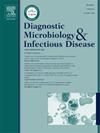Significance of the avidity test in IgM+/IgG+ patients infected with Toxoplasma gondii and cytomegalovirus and its relationship with demographic data
IF 1.8
4区 医学
Q3 INFECTIOUS DISEASES
Diagnostic microbiology and infectious disease
Pub Date : 2025-09-26
DOI:10.1016/j.diagmicrobio.2025.117126
引用次数: 0
Abstract
Background
IgG avidity testing is a valuable tool in distinguishing recent from past infections. This study presents a large-scale evaluation of IgG avidity test results for Toxoplasma gondii (toxoplasmosis) and Cytomegalovirus infections among IgM+/IgG+ patients, exploring its relationship with demographic factors with in a tertiary hospital.
Methods
Toxoplasma and CMV IgG/IgM levels were measured using the chemiluminescent microparticle immunoassay method. IgG avidity was assessed in IgM+/IgG+ serum samples using Micro ELISA System for Toxoplasma gondii and electrochemiluminescence immunoassay method for Cytomegalovirus. Avidity indices were analyzed in relation to demographic data using SPSS software.
Results
Between 2017 and 2024, 15,034 CMV-IgG, 20,090 CMV-IgM, and 5,693 CMV-IgG avidity tests were performed. Among 212 CMV cases analyzed for avidity (mean age 25.89 ± 26.13 years, 54.2 % male), 69.8 % had high avidity and 17.9 % had low avidity. Similarly, 14,937 Toxo-IgG, 19,895 Toxo-IgM and 4,623 Toxo-IgG avidity tests were performed. Of the 180 cases analyzed for avidity (mean age 30.01 ± 14.66 years, 85.0 % female); 70.0 % had high avidity and 15.6 % had low avidity.
Conclusion
In suspected Toxoplasma and CMV infections, combined IgG/IgM testing followed by IgG avidity testing is crucial for determining infection timing. Collaboration between clinicians and laboratory specialists is vital for accurate diagnosis and management, considering demographic factors.
弓形虫和巨细胞病毒感染患者IgM+/IgG+抗体检测的意义及其与人口统计学数据的关系
背景:血清学检测是区分新近感染和过去感染的一种有价值的工具。本研究对某三级医院IgM+/IgG+患者弓形虫和巨细胞病毒感染IgG抗体检测结果进行了大规模评价,探讨其与人口统计学因素的关系。方法采用化学发光微粒子免疫分析法检测人巨细胞病毒IgG/IgM水平。采用刚地弓形虫微酶联免疫吸附测定系统和巨细胞病毒电化学发光免疫分析法对血清IgM+/IgG+样品进行免疫活性测定。使用SPSS软件分析贪婪指数与人口统计学数据的关系。结果2017 - 2024年共开展CMV-IgG、CMV-IgM、CMV-IgG抗体检测15034例、20090例、5693例。在212例CMV病例中(平均年龄25.89±26.13岁,54.2%为男性),69.8%为高发病率,17.9%为低发病率。同样,进行了14937例弓形虫igg、19895例弓形虫igm和4623例弓形虫igg抗体检测。180例患者中,平均年龄(30.01±14.66岁),女性85.0%;高贪婪度占70.0%,低贪婪度占15.6%。结论在疑似弓形虫和巨细胞病毒感染病例中,IgG/IgM联合检测和IgG抗体检测是确定感染时机的重要方法。考虑到人口因素,临床医生和实验室专家之间的合作对于准确诊断和管理至关重要。
本文章由计算机程序翻译,如有差异,请以英文原文为准。
求助全文
约1分钟内获得全文
求助全文
来源期刊
CiteScore
5.30
自引率
3.40%
发文量
149
审稿时长
56 days
期刊介绍:
Diagnostic Microbiology and Infectious Disease keeps you informed of the latest developments in clinical microbiology and the diagnosis and treatment of infectious diseases. Packed with rigorously peer-reviewed articles and studies in bacteriology, immunology, immunoserology, infectious diseases, mycology, parasitology, and virology, the journal examines new procedures, unusual cases, controversial issues, and important new literature. Diagnostic Microbiology and Infectious Disease distinguished independent editorial board, consisting of experts from many medical specialties, ensures you extensive and authoritative coverage.

 求助内容:
求助内容: 应助结果提醒方式:
应助结果提醒方式:


